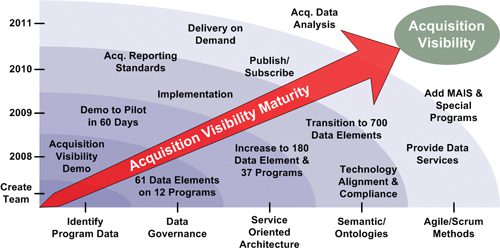A Case Study for Change
Acquisition Visibility is a case study in cross-organizational leadership, the use of best business practices, and technical competency within the Federal Government. Implementing this service required a significant amount of leadership, change management, and alignment of disparate defense organizations from Acquisition Visibility delivery teams. Teams constantly engaged and collaborated with acquisition organizations across the Department. They remained flexible to address leadership’s ever-changing data, service and technical requirements. Support constantly evolved as Acquisition Visibility adapted to and embraced cutting-edge technologies and concepts improving performance. In addition, AV leadership deliberately used agile methodologies to create synergies among delivery teams, including the Components, to meet strategic, functional, data and technical requirements more effectively.
Acquisition leadership agrees this remains an optimal approach despite the need for perpetual agility. By having instant access to authoritative acquisition information, leadership has insight into major acquisition programs more effectively. Performance data ensures Components are meeting cost, budget and specification targets while offering clues as to why certain programs may not be meeting their performance objectives. Data-driven decisions will help the Department address and overcome current and future acquisition challenges, whether organizational, budgetary or technical. The Department can reliably report on the performance and status of each major acquisition program to stakeholders – and Congress – to improve transparency. The ability to capture growing amounts of acquisition information exposes the Department to the strengths of data analytics, providing leadership with even more powerful information to drive critical decision making and oversight in the future.
Viewing Acquisition Visibility from strategic, functional and technical perspectives provides insight as to why the Department created this service to be the authoritative source for acquisition information and the primary tool to improve management, oversight and decision making on the acquisition portfolio. These perspectives highlight how and why specific techniques were used, their impact to operations, and the benefits of using these strategies, so other organizations can replicate similar techniques across Department.
|
Table 1 |
|
|
Action or Activity |
Impact on Acquisition Management and the Acquisition Portfolio |
| Development of an information sharing framework |
|
| Deliberate and perpetual use of agile methodologies |
|
Strategic Perspective: Acquisition Visibility was an effective means to provide structured, and eventually unstructured, acquisition data and reports to leadership and acquisition stakeholders. Use of acquisition information – as a service – exploded as DoD leadership realized the value of authoritative, reliable acquisition information to manage, oversee and support informed decision making on major acquisition expenditures. Consequently, Acquisition Visibility’s vision and mission has adapted since its pilot/implementation phase to account for the USD(AT&L)’s data requirements and growing uses for acquisition information. DoD leadership expects and requires timely, “ground truth” information regarding the acquisition portfolio, and Acquisition Visibility evolved into the service that provides it to them. What was once organizationally consuming to manage (data), is now a real-time data service executed by strong governance and technical competency. To implement this type of service, AV leadership needed a strategic information framework to manage acquisition information across the Department (Table 1). This framework needed to identify data requirements, support both functional and technical processes, and posses the appropriate infrastructure to connect with acquisition leadership. This framework needed to be agile with a focus on immediately – both effectively and efficiently – responding to acquisition leadership.
Functional Perspective: Customers who use service providers rarely consider the processes or technical infrastructure needed to meet their requirements; they simply demand the service they request as expeditiously as possible. A key component to Acquisition Visibility’s success is the delivery teams’ focus on end-users’ (customers) requirements for acquisition information. Thus, the service provides the right information through functions that are easy to use while meeting leadership’s demands at the same time. USD(AT&L) leadership ensures collaboration across organizational boundaries to obtain acquisition information. This collaborative environment lets delivery teams not only understand the type of information end-users need, it also allows them to understand how end-users would like to obtain, access and see the data. Governance and enterprise-level business process modeling (Table 2) streamlines and aligns business processes and rules across the Department to allow Acquisition Visibility to meet acquisition data requirements more effectively (Components maintain the flexibility to management their own internal data processes as appropriate).
|
Table 2 |
|
|
Action or Activity |
Impact on Acquisition Management and the Acquisition Portfolio |
| Enterprise-level data governance |
|
| Adoption of business process modeling techniques |
|
|
Table 3 |
|
|
Action or Activity |
Impact on Acquisition Management and the Acquisition Portfolio |
| Use of SOA as the core of net-centricity |
|
| Focus on leveraging services and tools that already exist |
|
| Publish and subscribe approach |
|


